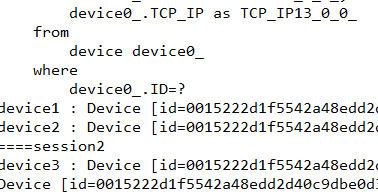Hibernate 二级缓存配置
Hibernate之一级缓存和二级缓存
hibernate升级到4.3二级缓存cache配置改变了
原来是hibernate.cache.provider_class = org.hibernate.cache.EhCacheProvider
hibernate4.3的要改成:
hibernate.cache.provider_class =net.sf.ehcache.hibernate.EhCacheProvider
这还不够,还要加上下面这个,否则一样报错
hibernate.cache.region.factory_class=org.hibernate.cache.ehcache.EhCacheRegionFactory
详见:https://www.cnblogs.com/Junsept/p/7324981.html
https://blog.csdn.net/feiyu1001/article/details/3173942
https://blog.csdn.net/culous/article/details/53355767
Hibernate的cache管理:
Cache就是缓存,它往往是提高系统性能的最重要手段,对数据起到一个蓄水池和缓冲的作用。Cache对于大量依赖数据读取操作的系统而言尤其重要。在大并发量的情况下,如果每次程序都需要向数据库直接做查询操作,它们所带来的性能开销是显而易见的,频繁的网络舆,数据库磁盘的读写操作都会大大降低系统的性能。此时如果能让数据库在本地内存中保留一个镜像,下次访问的时候只需要从内存中直接获取,那么显然可以带来不小的性能提升。引入Cache机制的难点是如何保证内存中数据的有效性,否则脏数据的出现将会给系统带来难以预知的严重后果。虽然一个设计得很好的应用程序不用Cache也可以表现出让人接受的性能,但毫无疑问,一些对读取操作要求比较高的应用程序可以通过Cache获得更高的性能。对于应用程序,Cache通过内存或磁盘保存了数据库中的当前有关数据状态,它是一个存储在本地的数据备份。Cache位于数据库和应用程序之间,从数据库更新数据,并给程序提供数据。
Hibernate实现了良好的Cache机制,可以借助Hibernate内部的Cache迅速提高系统的数据读取性能。Hibernate中的Cache可分为两层:一级Cache和二级Cache。
一级缓存:
Hibernate默认是开启一级缓存的,一级缓存存放在session上,属于事务级数据缓冲。
二级缓存:
二级缓存是在SessionFactory,所有的Session共享同一个二级Cache。二级Cache的内部如何实现并不重要,重要的是采用哪种正确的缓存策略,以及采用哪个Cache提供器。
在Hibernate中使用EhCache:
1)hibernate.cfg.xml 中增加对二级缓存的配置(maven项目放在resources文件夹下)
<?xml version='1.0' encoding='utf-8'?>
<!DOCTYPE hibernate-configuration PUBLIC
"-//Hibernate/Hibernate Configuration DTD 3.0//EN"
"http://www.hibernate.org/dtd/hibernate-configuration-3.0.dtd"> <hibernate-configuration> <session-factory>
<!-- Database connection settings -->
<property name="connection.driver_class">com.mysql.jdbc.Driver</property>
<property name="connection.url">jdbc:mysql://localhost:3306/test?characterEncoding=GBK</property>
<property name="connection.username">root</property>
<property name="connection.password">admin</property>
<!-- SQL dialect -->
<property name="dialect">org.hibernate.dialect.MySQLDialect</property>
<property name="current_session_context_class">thread</property>
<property name="show_sql">true</property>
<property name="hbm2ddl.auto">update</property> <property name="hibernate.cache.use_second_level_cache">true</property>
<prop key="hibernate.cache.use_query_cache">true</prop>
<property name="hibernate.cache.provider_class">org.hibernate.cache.EhCacheProvider</property> <mapping resource="com/how2java/pojo/Product.hbm.xml" />
<mapping resource="com/how2java/pojo/Category.hbm.xml" />
<mapping resource="com/how2java/pojo/User.hbm.xml" /> </session-factory> </hibernate-configuration>
说明一下:如果不设置“查询缓存”,那么hibernate只会缓存使用load()方法获得的单个持久化对象,如果想缓存使用findall()、list()、Iterator()、createCriteria()、createQuery()等方法获得的数据结果集的话,就需要设置hibernate.cache.use_query_cache true 才行
如果需要“查询缓存”,还需要在使用Query或Criteria()时设置其setCacheable(true);属性
hibernate升级到4.3二级缓存cache配置改变了
原来是hibernate.cache.provider_class = org.hibernate.cache.EhCacheProvider
hibernate4.3的要改成:
hibernate.cache.provider_class =net.sf.ehcache.hibernate.EhCacheProvider
这还不够,还要加上下面这个,否则一样报错
hibernate.cache.region.factory_class=org.hibernate.cache.ehcache.EhCacheRegionFactory
2)ehcache.xml用户EhCache配置(maven项目放在resources文件夹下)
<ehcache>
<diskStore path="java.io.tmpdir"/>
<defaultCache
maxElementsInMemory="10000"
eternal="false"
timeToIdleSeconds="120"
timeToLiveSeconds="120"
overflowToDisk="true"
/>
</ehcache>
<?xml version="1.0" encoding="UTF-8"?>
<ehcache>
<diskStore path="java.io.tmpdir"/>
<defaultCache
maxElementsInMemory="10000" <!-- 缓存最大数目 -->
eternal="false" <!-- 缓存是否持久 --> overflowToDisk="true" <!-- 是否保存到磁盘,当系统当机时--> timeToIdleSeconds="300" <!-- 当缓存闲置n秒后销毁 -->
timeToLiveSeconds="180" <!-- 当缓存存活n秒后销毁-->
diskPersistent="false"
diskExpiryThreadIntervalSeconds= "120"/>
</ehcache>
Ehcache的配置说明 <ehcache>
<!--
磁盘存储配置:
用来指定缓存在磁盘上的存储位置。可以使用JavaVM环境变量(user.home, user.dir, java.io.tmpdir)
-->
<diskStore path = "/var/apps/cache/" />
<!--
指定CacheManagerEventListenerFactory,这个对象在缓存添加的时候会得到相应的通知
CacheManagerEventListenerFactory的属性
*class - CacheManagerEventListenerFactory的一个实现类
*properties - CacheManagerEventListenerFactory的属性值,以逗号(,)分割多个属性
如果没有实现类被指定,则系统不创建CacheManager的监听器,没有默认值
-->
<cacheManagerEventListenerFactory class="" properties="" />
<!--
在进行分布式缓存的应用时候需要指定CacheManagerPeerProviderFactory,
用来生成CacheManagerPeerProvider的实例,以便和集群中的其他CacheManager通信。
*class -CacheManagerPeerProviderFactory的一个实现类
*properties - CacheManagerPeerProviderFactory的属性值,以逗号(,)分割多个属性
Ehcache内建了2种基于RMI分布系统的通信策略:
*automatic - 使用多播组。在一个节点加入或者推出集群的时候自动感应
*manual - 硬编码方式 目前的awf中不考虑分布缓存
-->
<cacheManagerPeerListenerFactory class="" properties="" />
<!--
缓存配置。
以下属性是必须的:
name - cache的标识符,在一个CacheManager中必须唯一
maxElementsInMemory - 在内存中缓存的element的最大数目
maxElementsOnDisk - 在磁盘上缓存的element的最大数目
eternal - 设定缓存的elements是否有有效期。如果为true,timeouts属性被忽略
overflowToDisk - 设定当内存缓存溢出的时候是否将过期的element缓存到磁盘上
以下属性是可选的:
timeToIdleSeconds - 缓存element在过期前的空闲时间。默认为0,表示可空闲无限时间.
(如果指定了这个时间,是否在被hit的前超过了这个时间就会被remove?在内存缓存数目超限之前不会被remove)
timeToLiveSeconds - 缓存element的有效生命期。这个类似于timeouts,默认为0,不过期
(是否通常情况下应该大于等于timeToIdleSeconds,小于会如何?idle时间也会减小和这个数值一样)
diskPersistent - 在VM重启的时候是否持久化磁盘缓存,默认是false。
(测试一下true的情况?重载vm的时候会从磁盘进行序列化到对象)
diskExpiryThreadIntervalSeconds - 磁盘缓存的清理线程运行间隔,默认是120秒.
(测试一下0的时候会如何)
memoryStoreEvictionPolicy - 当内存缓存达到最大,有新的element加入的时候,
移除缓存中element的策略。默认是LRU,可选的有LFU和FIFO 可对缓存中的element配置诸如监听器和加载器。Ehcahe内建了一些
*cacheEventListenerFactory - 监听缓存中element的put, remove, update和expire事件
*bootstrapCacheLoaderFactory - 启动时加载缓存的element
每个用来做分布式缓存都必须设定element的事件监听器,用来在各个CacheManager节点复制消息。
Ehcache内建了基于RMI的实现 - RMICacheReplicatorFactory
<cacheEventListenerFactory class="net.sf.ehcache.distribution.RMICacheReplicatorFactory"
properties="replicateAsynchronouly=true,
replicatePuts=true,
replicateUpdates=true,
replicateUpdateViaCopy=true,
replicateRemovals=true" /> -->
<cache .... />
<!--
默认的Cache配置。用来实现CacheManager.add(String cacheName)创建的缓存
-->
<defaultCache maxElementsInMemory="10000" eternal="false"
timeToIdleSeconds="120" timeToLiveSeconds="120"
overflowToDisk="true" maxElementsOnDisk="1000000"
diskPersistent="false" diskExpiryThreadIntervalSeconds="120"
memoryStoreEvictionPolicy="LRU"
/> </ehcache>
3)设置hbm
对于要进行二级缓存的实体类,进行配置,增加
1:事务(Transaction)仅在受管理的环境中可用。它保证可重读的事务隔离级别,可以对读/写比例高,很少更新的数据采用该策略。
2:读写(read-write)使用时间戳机制维护读写提交事务隔离级别。可以对读/写比例高,很少更新的数据采用该策略。
3:非严格读写(notstrict-read-write)不保证Cache和数据库之间的数据库的一致性。使用此策略时,应该设置足够的缓存过期时间,否则可能从缓存中读出脏数据。当一些数据极少改变,并且当这些数据和数据库有一部份不量影响不大时,可以使用此策略。
4:只读(read-only)当确保数据永不改变时,可以使用此策略。
<?xml version="1.0"?>
<!DOCTYPE hibernate-mapping PUBLIC
"-//Hibernate/Hibernate Mapping DTD 3.0//EN"
"http://www.hibernate.org/dtd/hibernate-mapping-3.0.dtd"> <hibernate-mapping package="com.domain">
<class name="Category" table="category">
<cache usage="read-write" /><!-- 二级缓存配置 -->
<id name="id" column="id">
<generator class="native">
</generator>
</id>
<property name="name" column="name"/>
</class> </hibernate-mapping>
<class name="Videos" table="TEST" lazy="false">
<cache usage="read-write" region="ehcache.xml中的name的属性值"/>注意:这一句需要紧跟在class标签下面,其他位置无效。
hbm文件查找cache方法名的策略:如果不指定hbm文件中的region="ehcache.xml中的name的属性值",则使用name名为com.ouou.model.Videos的cache,
如果不存在与类名匹配的cache名称,则用defaultCache。
如果Videos包含set集合,则需要另行指定其cache
例如Videos包含Tags集合,则需要
添加如下配置到ehcache.xml中
<cache name="com.ouou.model.Tags"
maxElementsInMemory="10000" eternal="false" timeToIdleSeconds="120"
timeToLiveSeconds="120" overflowToDisk="false" />
另,针对查询缓存的配置如下:
<cache name="org.hibernate.cache.UpdateTimestampsCache"
maxElementsInMemory="5000"
eternal="true"
overflowToDisk="true"/>
<cache name="org.hibernate.cache.StandardQueryCache"
maxElementsInMemory="10000"
eternal="false"
timeToLiveSeconds="120"
overflowToDisk="true"/>
**也可以用Hibernate注解配置缓存实体类**
**Java代码
@Entity
@Table
@Cache(usage = CacheConcurrencyStrategy.READ_WRITE)
public class User implements Serializable {
private static final long serialVersionUID = -5121812640999313420L;
private Integer id;
private String name; ......
}**
4)测试效果
使用不同的session,都去获取id=1的category,只会访问一次数据库。因为第二次获取虽然没有从第二个session中拿到缓存,但是从sessionfactory中拿到了Category缓存对象。
log1
Hibernate: select category0_.id as id1_0_, category0_.name as name1_0_ from category category0_ where category0_.id=?
log2
log3
//一级缓存session
System.out.println("log1");
Category c1 = (Category)session.get(Category.class, 1);
System.out.println("log2");
Category c2 = (Category)session.get(Category.class, 1);//不会显示SQL语句
//提交事务
session.getTransaction().commit();
//二级缓存SessionFactory
Session session2 = factory.openSession();
session2.beginTransaction();
System.out.println("log3");
Category p3 = (Category) session2.get(Category.class, 1);//不会显示
session2.getTransaction().commit();
5)注意事项
maven所需包,hibernate 3.0版本,hibernate-ehcache
<dependency>
<groupId>org.hibernate</groupId>
<artifactId>hibernate-core</artifactId>
<version>3.6.10.Final</version>
</dependency> <dependency>
<groupId>org.hibernate</groupId>
<artifactId>hibernate-ehcache</artifactId>
<version>3.6.7.Final</version>
</dependency>
实际操作:
1.ehcache.xml(maven项目放在resources文件夹下):基本为默认配置
<?xml version="1.0" encoding="UTF-8"?>
<ehcache>
<diskStore path="java.io.tmpdir"/>
<defaultCache
maxElementsInMemory="10000"
eternal="false"
timeToIdleSeconds="120"
timeToLiveSeconds="120"
overflowToDisk="true"
/>
</ehcache>
2.实体类
@Entity
@Table(name="device")
@Cache(usage = CacheConcurrencyStrategy.READ_WRITE)
public class Device { }
3.maven依赖
<!--hibernate core -->
<dependency>
<groupId>org.hibernate</groupId>
<artifactId>hibernate-core</artifactId>
<version>4.3.11.Final</version>
</dependency> <!--hibernate cache -->
<dependency>
<groupId>org.hibernate</groupId>
<artifactId>hibernate-ehcache</artifactId>
<version>4.3.11.Final</version>
</dependency>
4.hibernate 配置
<prop key="hibernate.cache.use_second_level_cache">true</prop>
<prop key="hibernate.cache.use_query_cache">true</prop>
<prop key="hibernate.cache.provider_class">net.sf.ehcache.hibernate.EhCacheProvider</prop>
<prop key="hibernate.cache.region.factory_class">org.hibernate.cache.ehcache.EhCacheRegionFactory</prop>
5.测试实现类
@Override
public Device getDeviceFromSecondCache(String deviceId) {
// TODO Auto-generated method stub
System.out.println("====session1");
Session session1 = sessionFactory.openSession();
Transaction transaction1 = session1.getTransaction();
transaction1.begin();
Device device1 = (Device) session1.get(Device.class, deviceId);
System.out.println("device1 : " + device1);
Device device2 = (Device) session1.get(Device.class, deviceId);//不会显示sql
System.out.println("device2 : " + device2);
//提交事务
transaction1.commit(); System.out.println("====session2");
Session session2= sessionFactory.openSession();
Transaction transaction2 = session2.getTransaction();
transaction2.begin();
Device device3 = (Device) session1.get(Device.class, deviceId);
//提交事务
System.out.println("device3 : " + device2);
transaction2.commit(); return device2; }
@Test
@Transactional
public void testGet(){
//System.out.println(testDao.getDeviceById("0015222d1f5542a48edd2d40c9dbe0d3"));
//testDao.saveDevice(null); testDao.getDeviceFromSecondCache("0015222d1f5542a48edd2d40c9dbe0d3");
}
运行结果只进行一次sql查询

Hibernate 二级缓存配置的更多相关文章
- Hibernate二级缓存配置
一.定义: 二级缓存是进程或集群范围内的缓存,可以被所有的Session共享,是可配置的插件 二.二级缓存原理图 解析:每次从二级缓存中取出的对象,都是一个新的对象. 三.配置步骤如下: 同理:以员工 ...
- Hibernate 二级缓存配置出现的异常
1.java.lang.ExceptionInInitializerError at sun.reflect.NativeConstructorAccessorImpl.newInstance0(Na ...
- hibernate二级缓存整合
<?xml version="1.0" encoding="UTF-8"?> <ehcache xmlns:xsi="http:// ...
- spring boot集成ehcache 2.x 用于hibernate二级缓存
https://www.jianshu.com/p/87b2c309b776 本文将介绍如何在spring boot中集成ehcache作为hibernate的二级缓存.各个框架版本如下 spring ...
- 配置Hibernate二级缓存时,不能初始化RegionFactory的解决办法
配置Hibernate 二级缓存时,出现以下bug提示: SLF4J: Failed to load class "org.slf4j.impl.StaticLoggerBinder&quo ...
- 配置Hibernate二级缓存步骤
配置Hibernate二级缓存步骤: 加入二级缓存的jar包及配置文件 jar包位置:hibernate-release-4.1.8.Final\lib\optional\ehcache下所有jar包 ...
- Hibernate二级缓存简述及基于Spring4,Hibernate5,Ehcache3的二级缓存配置
Hibernate L2缓存 缓存的分类 L2缓存工作原理 放入二级缓存的数据 Ehcache 依赖 ehcache.xml 常用的memoryStoreEvictionPolicy(缓存算法) eh ...
- ssh整合hibernate 使用spring管理hibernate二级缓存,配置hibernate4.0以上二级缓存
ssh整合hibernate 使用spring管理hibernate二级缓存,配置hibernate4.0以上二级缓存 hibernate : Hibernate是一个持久层框架,经常访问物理数据库 ...
- hibernate二级缓存ehcache hibernate配置详解
<!-----------------hibernate二级缓存ehcache------------------------->hibernate配置 <prop key=&quo ...
随机推荐
- 【奔走相告】- Github送福利:用户可免费创建私有代码库啦
最新消息 PingWest品玩1月8日讯,据TheNextWeb消息,据美国科技媒体The Next Web报道,被微软收购的代码平台GitHub最近调整政策,用户免费创建无限空间私有代码库(priv ...
- 大叔来说说Markdown的使用
强调和高亮背景 中国是伟大的民族! Highlight 中国是`伟大`的民族! ==Highlight== 链接 大叔博客园 [大叔博客园](http://www.cnblogs.com/lori & ...
- chrome版本与对应的chromedriver驱动【转载】
chrome版本与对应的谷歌驱动(chromedriver) 1.下载chromedriver:http://chromedriver.storage.googleapis.com/index.htm ...
- 如何让你的网站用上免费的HTTPS
因为之前网站上被注入了广告,再百般尝试之后最后还是使用了HTTPS解决了. 在实现HTTPS的时候最关键的就是证书. 证书的质量觉得了你被多少浏览器所信任. 证书的价格也就蹭蹭蹭往上涨了. 这里推荐一 ...
- 高可用Hadoop平台-运行MapReduce程序
1.概述 最近有同学反应,如何在配置了HA的Hadoop平台运行MapReduce程序呢?对于刚步入Hadoop行业的同学,这个疑问却是会存在,其实仔细想想,如果你之前的语言功底不错的,应该会想到自动 ...
- 装饰者模式——Java设计模式
装饰模式 1.概念 动态地为对象附加上额外的职责 其目的是包装一个对象,从而可以在运行时动态添加新的职责.每个装饰器都可以包装另一个装饰器,这样理论上来说可以对目标对象进行无限次的装饰. 2.装饰器类 ...
- SpringBoot入门 (十四) Security安全控制
本文记录在SpringBoot使用SpringSecurity进行安全访问控制. 一 什么是Security Spring Security是一个能够为基于Spring的企业应用系统提供声明式的安全访 ...
- MySQL 5.7 新备份工具mysqlpump 使用说明 - 运维小结
之前详细介绍了Mysqldump备份工具使用,下面说下MySQL5.7之后新添加的备份工具mysqlpump.mysqlpump是mysqldump的一个衍生,mysqldump备份功能这里就不多说了 ...
- Docker环境下搭建DNS LVS(keepAlived) OpenResty服务器简易集群
现在上网已经成为每个人必备的技能,打开浏览器,输入网址,回车,简单的几步就能浏览到漂亮的网页,那从请求发出到返回漂亮的页面是怎么做到的呢,我将从公司中一般的分层架构角度考虑搭建一个简易集群来实现.目标 ...
- 测试本地node包
@subject: 测试本地node包 @author: leinov @date: 2018-10-25 当我们编写一个node包,在发布到npm上之前,需要在本地测试该包.假设我们有一个已经编写好 ...
